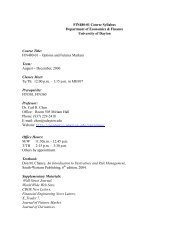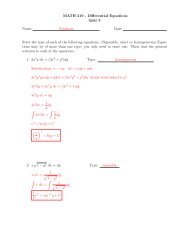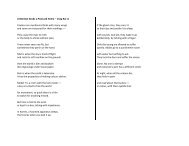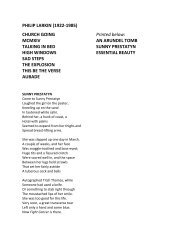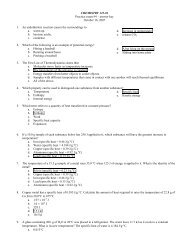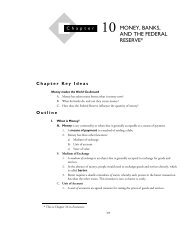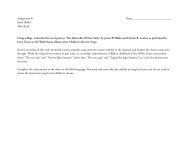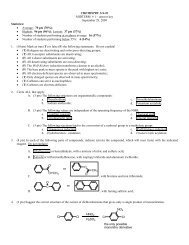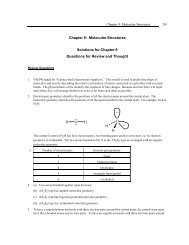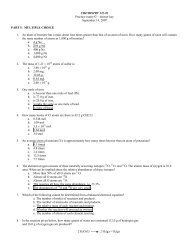Physics 206 Example Problems Newton's Laws of Motion
Physics 206 Example Problems Newton's Laws of Motion
Physics 206 Example Problems Newton's Laws of Motion
Create successful ePaper yourself
Turn your PDF publications into a flip-book with our unique Google optimized e-Paper software.
Solution : If the box is not to slip it must have the same acceleration as the truck. The forces acting on<br />
the box are a static frictional force, the normal force and the gravitational pull <strong>of</strong> the earth on the box.<br />
The static frictional force points in a direction so as to maintain no relative motion <strong>of</strong> the box and the<br />
truck. In this case that means that the static frictional force points in the direction <strong>of</strong> the acceleration<br />
since in fact, it is the force responsible for the acceleration <strong>of</strong> the box. A free body diagram is shown<br />
below.<br />
In this coordinate system the forces have the form,<br />
Applying Newton’ s second law in the y-direction gives,<br />
N<br />
y<br />
x<br />
m<br />
N<br />
= Nyˆ F<br />
G = − m gE yˆ F<br />
S = µS Nxˆ<br />
FG<br />
FS<br />
N − m gE = 0 ⇒ N = m gE<br />
Applying the second law in the x-direction and using the above result gives,<br />
Solving for the x-component <strong>of</strong> the acceleration gives,<br />
µS N = m ax ⇒ µS m gE = m ax<br />
ax = µS gE = 0. 4 ( 9. 8) m/s 2 = 3. 92 m/s 2<br />
Problem 9. Two blocks are connected by a massless, rigid rod and placed on an inclined plane as shown<br />
in the figure below. The blocks have masses m1 and m2 and coefficients <strong>of</strong> kinetic friction ( with the plane)<br />
<strong>of</strong> µK1 and µK2.<br />
A) Find a symbolic formula for the acceleration <strong>of</strong> the system.<br />
B) Find a symbolic expression for the force that the connecting rod exerts on either block.<br />
C) Show that the force from part B) is zero when µK1 = µK2.<br />
Solution : The free body diagrams for the two blocks looks like,<br />
y<br />
FK1<br />
m1<br />
θ<br />
FG1<br />
N1<br />
Fron1<br />
x<br />
m1<br />
Note that I have chosen the usual coordinate systems for inclined planes. In this coordinate system the<br />
forces that act on block 1 can be written as,<br />
¡<br />
N<br />
¡<br />
1 = N1 yˆ F<br />
m2<br />
¡<br />
G1 = m1 gE sinθ xˆ − m1 gE cosθ yˆ F<br />
The forces that act on mass 2 can be written as,<br />
¡<br />
N<br />
¡<br />
2 = N2 yˆ F<br />
¡<br />
G2 = m2 gE sinθ xˆ − m2 gE cosθ yˆ F<br />
6<br />
θ<br />
FK2<br />
Fron2<br />
m2<br />
θ<br />
¡<br />
ron1 = Txˆ F<br />
FG2<br />
¡<br />
ron1 = − Txˆ F<br />
N2<br />
y<br />
x<br />
K 1 = − µK1 N1 xˆ<br />
K2 = − µK2 N2 xˆ




